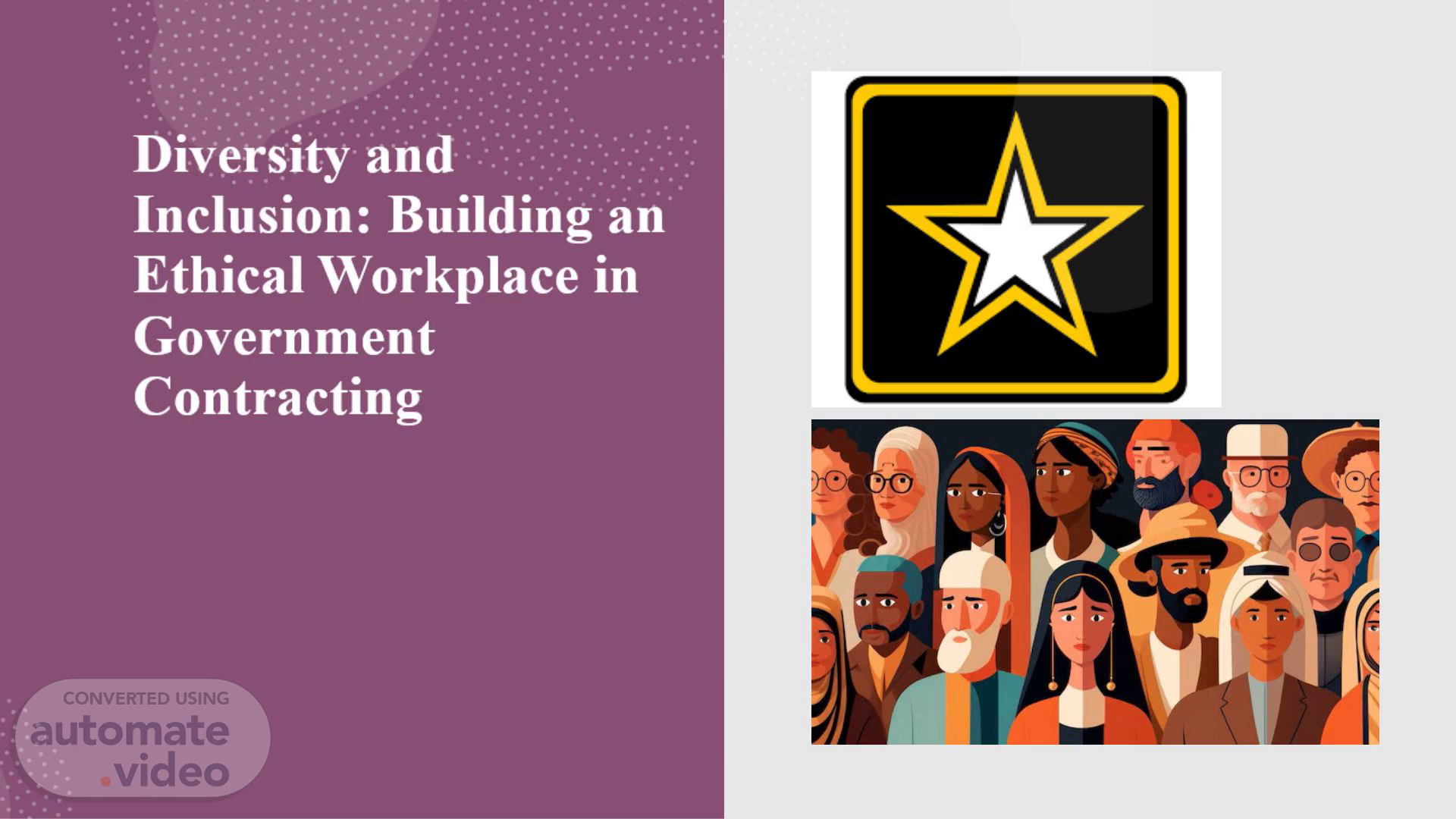
Diversity and Inclusion: Building an Ethical Workplace in Government Contracting
Scene 1 (0s)
[Virtual Presenter] Hello everyone. Today we’ll explore the concepts of diversity and inclusion particularly how they relate to creating an ethical workplace within the context of government contracting for the U S Army. I’ll also share examples from my own experience to illustrate these concepts and discuss challenges and recommendations for improvement..
Scene 2 (24s)
[Audio] In this presentation we'll begin by defining diversity and inclusion explaining their relevance to maintaining an ethical workplace. We'll then look at specific examples from our work with the U S Army identifying challenges we face and opportunities for improvement. Finally I'll provide recommendations to enhance our diversity and inclusion efforts..
Scene 3 (48s)
[Audio] Diversity encompasses the variety of differences among individuals within a team or organization including race gender age ethnicity and other personal attributes. In our role as government contractors diversity is reflected in the range of backgrounds and experiences our team members bring. For instance our team includes veterans from different branches of the military as well as civilians with specialized expertise in areas such as cybersecurity engineering and logistics. This diverse mix helps us tackle complex projects and provide innovative solutions to the U S Army..
Scene 4 (1m 29s)
[Audio] Inclusion refers to creating an environment where all individuals regardless of their diverse backgrounds feel respected valued and able to contribute fully. Within our team inclusion means actively ensuring that every member's input is considered in decision-making processes. For example during project planning meetings we make it a point to solicit feedback from all team members ensuring that diverse perspectives are integrated into our strategies and solutions. This approach helps us leverage the full potential of our diverse team..
Scene 5 (2m 5s)
[Audio] An ethical workplace is one where fairness respect and equal opportunity are prioritized. Embracing both diversity and inclusion contributes to these ethical principles by promoting equitable treatment and preventing biases. For example in our contracts with the U S Army we are committed to fair hiring practices and equal opportunities for advancement. This commitment ensures that all team members are treated with respect and have the chance to contribute meaningfully thereby upholding the ethical standards of our organization..
Scene 6 (2m 41s)
[Audio] Diversity in our workplace is evident through our team's varied professional backgrounds. For example we have individuals with extensive military experience such as former Army officers who bring deep insights into military operations alongside civilians with expertise in cutting-edge technologies. This blend of experience enriches our project outcomes and allows us to address the U S Army's needs more effectively. By integrating different perspectives we can develop comprehensive solutions that address a wide range of challenges..
Scene 7 (3m 16s)
[Audio] Inclusivity in our workplace involves actively engaging all team members and valuing their contributions. An example of this is our practice of holding regular inclusive team meetings where everyone is encouraged to share their ideas and feedback. For instance during a recent project review we ensured that both junior and senior staff had the opportunity to provide input on strategic decisions. This inclusive approach not only fosters a sense of belonging but also leads to more innovative and well-rounded solutions..
Scene 8 (3m 52s)
[Audio] Despite our efforts we face several challenges in fully integrating diversity and inclusion. One challenge is ensuring that diverse perspectives are consistently included in all stages of decision-making. We also encounter difficulties in addressing unconscious biases that may affect team dynamics. However these challenges present opportunities for growth. By implementing targeted training programs and developing robust feedback mechanisms we can enhance our inclusivity and better align with ethical standards..
Scene 9 (4m 26s)
[Audio] To strengthen our diversity and inclusion practices I recommend the following actions: First we should implement regular training sessions on unconscious bias and inclusive practices to help team members recognize and address potential biases. Second establishing feedback mechanisms such as anonymous surveys can provide insights into areas for improvement and ensure that all voices are heard. Lastly conducting periodic reviews of our diversity and inclusion practices will help us stay aligned with ethical standards and make necessary adjustments..
Scene 10 (5m 3s)
[Audio] In conclusion embracing both diversity and inclusion is essential for fostering an ethical workplace. By recognizing and valuing the diverse backgrounds of our team members and ensuring their full participation we create a more equitable and effective work environment. This approach not only aligns with our ethical commitments but also enhances our ability to meet the needs of the U S Army. Thank you for your attention and I'm open to any questions you may have..
Scene 11 (5m 32s)
[Audio] Here are the references used in this presentation. These sources provide further insights into the topics of diversity inclusion and ethical practices in government contracting. They include academic journals and trade publications that support our understanding and implementation of these concepts.